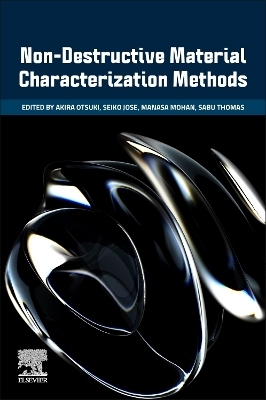
Non-Destructive Material Characterization Methods
Elsevier - Health Sciences Division (Verlag)
978-0-323-91150-4 (ISBN)
From there, elemental assay and mapping techniques are discussed, including Raman spectroscopy, UV spectroscopy, atomic absorption spectroscopy, neutron activation analysis, and various others. The book concludes with sections covering displacement measurement techniques, large-scale facility techniques, and methods involving multiscale analysis and advanced analysis.
Dr. Akira Otsuki is a Visiting Professor at Luleå University of Technology, and the Unit coordinator and leading professor of the unit “Mine Tailings at Universidad Adolfo Ibáñez. He is a member of several academic societies as well as an editor of academic journals including ChemEngineering and Recycling. He also serves as a guest editor of special issues, including “Colloidal/Fine Particle Aspects of Mine Tailings. His research focuses on characterization and processing of complex materials, including waste materials, natural ores, and colloids. He has been developing and running national and international research projects on his research focuses. Seiko Jose PhD is a scientist, working at ICAR-Central Sheep and Wool Research Institute, Avikanagar, Rajasthan, India. He has over 17 years’ experience in textiles including time spent in industry and academia. His industrial experience is focused on wet processing of cotton, silk, and linen processing units. For the last 8 eight years of his research career, he has worked with a range of natural fibres such as, wool, jute, pineapple leaf fibre, coir, flax, and ramie. He has contributed to 30 research papers and 9 book chapters. His major research areas are extraction and characterization of natural fibre, textile dyeing and finishing, eco-friendly textile processing, natural fibre composites, and natural dyes. Dr. Manasa Mohan A. graduated in 2010 from University of Kerala, India, completing post-graduation with first rank from the Department of Chemistry, and also received a gold medal in chemistry from the University of Kerala. She completed her PhD in polymer-based drug delivery systems in 2018. She is now working as a Kothari postdoctoral fellow in Mahathma Gandhi University, Kottayam, Kerala. Sabu Thomas is a Professor and Director of the International and Interuniversity Centre for Nanoscience and Nanotechnology, Mahatma Gandhi University, Kerala, India. Professor Thomas is internationally recognized for his contributions to polymer science and engineering, with his research interests encompassing polymer nanocomposites, elastomers, polymer blends, interpenetrating polymer networks, polymer membranes, green composites, nanocomposites, nanomedicine, and green nanotechnology. His groundbreaking inventions in polymer nanocomposites, polymer blends, green bionanotechnology, and nano-biomedical sciences have significantly advanced the development of new materials for the automotive, space, housing, and biomedical fields.
1. Introduction to Non-Destructive Material Characterizations 2. Optical Microscope (Interferometric and non- interferometric optical microscope techniques) 3. Polarized Microscope 4. Atomic Force Microscopy 5. Non-Destructive Imaging of Buried Interfaces Using Decelerated Electron-Beam in Scanning Electron Microscopy 6. Scanning Probe Microscope 7. Transmission Electron Microscope 8. Neutron Imaging 9. Infrared Thermography: Philosophy, Approaches, Analysis - Processing, and Guidelines 10. Non-Destructive Material Testing in Welding: Ultrasonic Scanning 11. Diffraction with X -Rays and Neutrons 12. Raman Spectroscopy - Part 1 13. Raman Spectroscopy - Part 2 14. UV-Vis Spectroscopy in Non-Destructive Testing 15. Hard X-ray Photoelectron Spectroscopy (HAXPES) and X-Ray Diffraction Techniques (XRD): Non-Destructive compositional, electronic, chemical and structural in-depth characterization in the tens-of-nanometer scale 16. X-ray Fluorescence Spectroscopy 17. Mass Spectrometry 18. Atomic Absorption Spectrophotometry 19. Dielectric Spectroscopy and Techniques 20. Element Analysis with Neutrons 21. X-ray Stress Analysis 22. Neutrons – Characteristics and Sources 23. NDT of Steel Components based upon their Magnetic Answer 24. Cloud-Based Non-Destructive Characterization 25. Complementary Results of Non-Destructive Elemental Assay and Liberation Analysis of Waste Printed Circuit Boards 26. Future Perspectives on Non-Destructive Material Characterization Methods towards Sustainability and Circular Economy
| Erscheinungsdatum | 09.09.2023 |
|---|---|
| Zusatzinfo | Approx. 300 illustrations; Illustrations |
| Verlagsort | Philadelphia |
| Sprache | englisch |
| Maße | 152 x 229 mm |
| Gewicht | 1540 g |
| Themenwelt | Naturwissenschaften ► Chemie ► Analytische Chemie |
| ISBN-10 | 0-323-91150-1 / 0323911501 |
| ISBN-13 | 978-0-323-91150-4 / 9780323911504 |
| Zustand | Neuware |
| Informationen gemäß Produktsicherheitsverordnung (GPSR) | |
| Haben Sie eine Frage zum Produkt? |
aus dem Bereich


